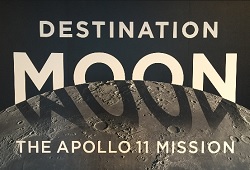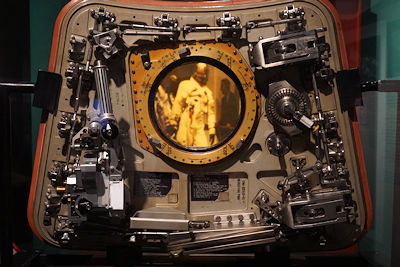
“That’s one small step for man, one giant leap for mankind.” With those words, the promise of a slain president and a dream that went back centuries was finally realized when Neil Armstrong became the first human to step foot on the surface of the Moon.
Two giants of science fiction – Jules Verne and H.G. Wells – crafted fictional narratives of the historical moment in 1865 and 1901, respectively, and one of the earliest motion pictures was inspired by both From the Earth to the Moon and The First Men in the Moon. Directed by Georges Méliès, A Trip to the Moon was released in 1902 and its image of a spacecraft protruding from the eye of the Man in the Moon is still iconic to this day.
A Trip to the Moon may have been the first but it was hardly the last film to depict traveling into space, with 1950s Destination Moon being the most realistic and influential. Instead of “The End” appearing after the final scene, the words “This is THE END… of the beginning” flashed onscreen, an epitaph that foreshadowed the upcoming Space Age.
In 2017, the Smithsonian Institute launched a traveling exhibit likewise entitled Destination Moon in celebration of humanity’s greatest achievement during the Space Age – the successful Moon landing of Apollo 11. From September 2018 through February 2019, the Senator John Heinz History Center in Pittsburgh was one of only four locales across the country to serve as a temporary home for Destination Moon, which included the Apollo 11 command module that brought astronauts Neil Armstrong, Buzz Aldrin, and Michael Collins safely back to Earth.
Like with most things during the time period – from Korea and Vietnam to atomic testing – the story of Apollo 11 begins with the Cold War. The post-World War II rivalry between the United States and the Soviet Union was never directly fought on the battlefield and extended beyond the scope of physical boundaries to include the realms of science and technology. Thus when the Soviet’s successfully launched the first artificial satellite into orbit on October 4, 1957, it was a blow to the American psyche and the belief that the nation could defeat and outshine the Soviets in any area of expertise.
On April 12, 1961, cosmonaut Yuri Gagarin added yet another milestone to the Soviet Union’s growing list of accomplishments when he became not only the first human to travel into space but the first to orbit the Earth as well.
The United States successfully launched its initial satellite – Explorer 1 – on January 31, 1958, and astronaut Alan Shepard became the first American in space a mere 23 days after Gagarin’s historic flight, but it was obvious to everyone across the country that the United States was lagging behind the Soviet Union. The disastrous Bay of Pigs military invasion of Cuba in April 1961 further led to the belief that the U.S. was losing the Cold War.
In order to both capitalize on the enthusiasm that American’s felt after Shepard’s flight and the need to outpace the Soviets, President John F. Kennedy delivered a speech to Congress on May 25, 1961, in which he declared, “I believe that this nation should commit itself to achieving the goal, before this decade is out, of landing a man on the Moon and returning him safely to Earth.”
It was as bold of a statement as any other in history. Although Alan Shepard successfully traveled into space, he did not orbit the Earth like Yuri Gagarin, merely breaking the atmosphere. Thus when Kennedy addressed Congress, the total time that any American spent in the outer realms of planet Earth was Shepard’s fifteen minute suborbital hop. Although an important step it was a small one nonetheless, and the amount of time, energy and ingenuity required to make the leap to landing on the Moon would require over 400,000 government and civilian personnel to accomplish.
But the United States was up to the task. Although new technology needed to be invented practically overnight – including a rocket powerful enough to lift a heavier payload, a capsule capable of reaching the Moon and returning, a lunar module to land on the Moon, computers powerful enough to make the necessary calculations, and a number of other advancements that went beyond human achievements of the past – President Kennedy’s goal came to fruition on July 20, 1969, when Apollo 11 successfully landed not one but two human beings on the lunar surface.
Destination Moon tells the story of those hundreds-of-thousands of men and women from across the country who worked together to make Kennedy’s pledge a reality. The Saturn V– still the tallest, heaviest, and most powerful rocket ever launched – was developed by a team of engineers at the Marshall Space Flight Center in Huntsville, Alabama, while the Apollo Command and Service Module (CSM) and the Lunar Excursion Module (LEM) were constructed by North American Aviation, which merged with the Pittsburgh-based Rockwell in 1967.
Apollo 11 launched on July 16, 1969, from the Kennedy Space Center in Cape Canaveral, Florida, while mission control was based in Houston, Texas. From that moment until splashdown eight days later, however, all eyes were upward and focused on three individual – Neil Armstrong from Wapakoneta, Ohio, Buzz Aldrin from Glen Ridge, New Jersey, and the raised-on-military-bases Michael Collins.
Within the section of Destination Moon that solely spotlighted the events from mid-July 1969 were an impressive area of artifacts, recreations, and information. The discarded first stages from the Saturn V that launched Apollo 11 had remained in the Atlantic Ocean until 2013 when Amazon founder and space enthusiast Jeff Bezos funded an expedition for their retrieval, and a recovered F-1 injector plate was part of the exhibit. The helmet and gloves that Buzz Aldrin wore on the Moon were also on display, as well as a felt tip pen that Aldrin brought with him on the journey.
While a pen may seem insignificant in comparison to the other artifacts, its historical importance is significant nonetheless. Wearing bulky space suits within the diminutive confines of the Lunar Module caused either Armstrong or Aldrin to inadvertently break the ascent engine breaker switch on the control panel. With only a small time window to rendezvous with the Apollo command module and now unable to launch from the Moon because of the broken switch, Aldrin inserted the tip of his pen into the small hole and used it to flip the switch.
While a helmet and gloves worn on the Moon are impressive and the story of the felt tip pen is entertaining, the centerpiece of Destination Moon was the Apollo 11 command module that not only traveled around the Moon but brought Neil Armstrong, Buzz Aldrin and Michael Collins safely back to Earth.
Measuring only ten feet, seven inches tall with a diameter of twelve feet, ten inches, the command module is an impressive sight to witness firsthand. Weathered and worn from its travels, and having enduring re-entry at the speed of 24,000 miles per hour, it remains intact and a feat of engineering unrivaled, especially when considering the short time span between Alan Shepard’s fifteen minute journey eight years earlier and July 1969.
It also adds to the perseverance of not only Armstrong, Aldrin, and Collins but all astronauts from the early years of space exploration. Strapping themselves inside a tin can on top of a giant rocket and being hurdled into the unknown made them true heroes and pioneers, and while the Apollo command module contained only 210 cubic feet for three astronauts, the previous Mercury and Gemini modules were even smaller and more restricting.
“A hundred year ago, Jules Verne wrote a book about a voyage to the Moon,” Neil Armstrong told a national audience on the eve of Apollo 11’s return to Earth. “His spaceship, Columbia, took off from Florida and landed in the Pacific Ocean after completing a trip to the Moon. It seems appropriate to us to share with you some of the reflections of the crew as modern-day Columbia completes its rendezvous with the planet Earth in the same Pacific Ocean tomorrow.”
Fifty years later, the Destination Moon exhibit likewise shared reflections from the journey of Apollo 11 – a journey dreamed of for centuries and made possible due to the efforts of a united nation to fulfill the promise of President John F. Kennedy, making one giant leap in the evolution of the human race in the process.
Anthony Letizia





